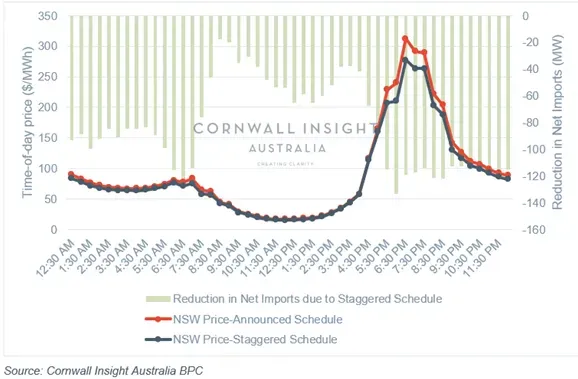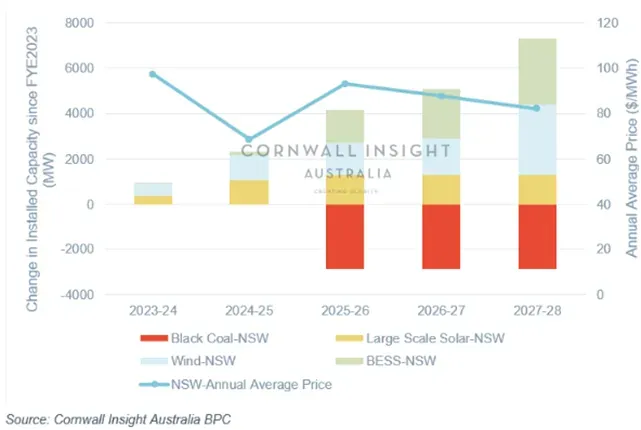"By providing time for the development and integration of new energy sources, we can minimise the impact on prices and reduce reliance on costly imports during the transition."
Dominic Pacaba Energy Modelling & Analytics Consultant
New modelling from Cornwall Insight Australia reveals that a staggered retirement of the Eraring power station would reduce the impact on energy prices in New South Wales (NSW) and lower net imports.
Unlike previous plant closures, Eraring will retire all four units simultaneously, with a scheduled shutdown of August 2025. This move will result in the removal of a significant 2,880MW of power capacity from the grid, placing upward pressure on prices in 2026. Slowing down the closure could help ensure there is enough installed renewable and energy storage capacity to mitigate the loss of energy from the power station.
Cornwall Insight Australia analysis forecasts that renewable sources, such as wind and solar projects, alongside increasing energy storage and energy imports from Queensland (QLD) will replace the retiring plant1. While this is expected to mitigate price increases to some extent, the projected timeline for installing capacity indicates this will be a gradual process up to 2028, meaning if Eraring is closed in 2025, there will be a need to rely on expensive imports while additional capacity is brought online.
The recently analysed data highlights the advantages of implementing a gradual shutdown plan instead. In the staggered scenario, one unit of Eraring would be closed by the end of 2026, followed by staggered closures of the remaining three units throughout 2027 and 2028.
Embracing a staggered approach allows NSW to adequately develop the necessary capacity to replace nearly 3GW of coal-fired power. Ensuring a smoother transition and reducing the impact on prices.
Figure 1: Effect on average time-of-day price ($/MWh) and reduction in net imports (MW in FY 2026 when spreading Eraring retirement to three years

Figure 2: Change in Installed capacity in NSW since FYE 2023 (MW) and Annual Average Price ($/MWh) from FYE 2024 to FYE 2028 based on a non-staggered closure of Eraring power station

Dominic Pacaba, Energy Modelling and Analytics Consultant at Cornwall Insight:
A staggered closure approach for Eraring power station presents a unique opportunity for New South Wales to effectively manage the transition towards a more sustainable energy future. By providing time for the development and integration of new energy sources, we can minimise the impact on prices and reduce reliance on costly imports during the transition. This strategic approach sets the stage for a smoother transition and paves the way for a resilient and affordable energy system in NSW.
If the full closure of Eraring does go ahead in 2025, NSW must ensure the timely delivery of schemes, such as the NSW Electricity Infrastructure Roadmap, Long-term Energy Service Agreements and major projects such as Snowy 2.0 and Project Energy Connect. That will be paramount to maintaining reliability and affordability of energy as NSW looks to meet its decarbonisation targets.”
Reference:
- Eraring functions as a dispatchable power plant and provides power during evening and early morning peak periods. We anticipate that renewable sources such as wind and energy storage will replace the retiring plant during the peak periods. The middle of the day period is expected to be served by the projected significant increase in rooftop PV installations, some new large-scale solar installations, and energy imports from QLD.
–Ends
Notes to Editors
For more information, please contact: Verity Sinclair at v.sinclair@cornwall-insight.com or Hollie Roberts at h.roberts@cornwall-insight.com.au
To link to our website, please use: https://www.cornwall-insight.com/au/
About the Cornwall Insight Group
Cornwall Insight is the pre-eminent provider of research, modelling, analysis, consulting and training to businesses and stakeholders engaged in the Australian, Great British, and Irish energy markets. To support our customers, we leverage a powerful combination of analytical capability, a detailed appreciation of regulation codes and policy frameworks, and a practical understanding of how markets function.

